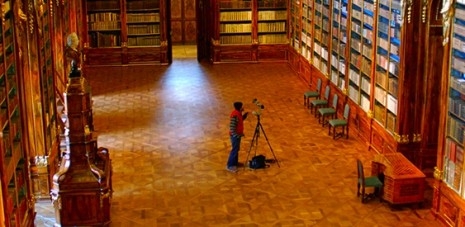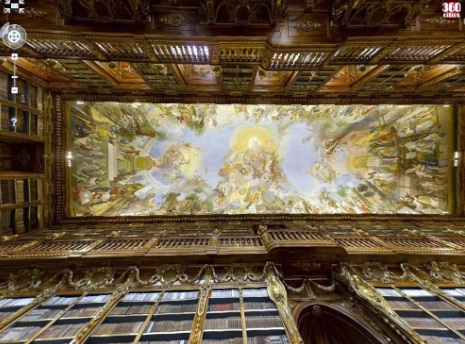
Photographer Jeffery Martin has created the “world’s largest indoor photograph: a 40-gigapixel, 360-degree image of the hall that weighs in at 283 GB.”
But that’s not all, for the photograph is of Prague’s Philosophical Hall, a rarely seen, Baroque reading room in the city’s 868-year-old Strahov monastery library.
As reported in Wired Martin has taken nearly 3,000 pictures to create the one giant panoramic view of the Strahov library, which is released today on Martin’s website. The finished image is a
...a zoomable, high-resolution peek inside one of Prague’s most beautiful halls, a repository of rare books that is usually off-limits to tourists (a few of whom can be seen standing behind the velvet rope at the room’s normal viewing station).
Martin’s panorama lets you examine the spines of the works in the Philosophical Hall’s 42,000 volumes, part of the monastery’s stunning collection of just about every important book available in central Europe at the end of the 18th century — more or less the sum total of human knowledge at the time.
Martin got special permission from the library to pursue the project. He didn’t, however, get permission to wear his street shoes indoors. He’s complemented his fingerless gloves and down vest — it’s cold in here — with a pair of oversize, felt-soled slippers for the sake of the polished parquet floor.
To capture the images, the German-made GigaPanBot sends the camera on a pattern that starts at the very top of the library, going back and forth in rows, working its way downward over five days of shooting.
“I started from the ceiling, and by the time they kicked me out at 5 p.m. the first day, I had done maybe 20 percent of the hall,” Martin says. “So I hit pause and left everything right where it was until the next morning. That’s one advantage of shooting in an 18th-century library — my camera is the least valuable thing in the room.”
The next step: turning 2,947 individual shots into a single picture. It’ll take a day of mostly automated post-processing to correct colors and exposures from RAW image files.
“That dark corner and the bright ceiling are shot at the same exposure,” Martin says. “My goal is to get something that doesn’t have dark spots and bright spots — and also something that looks natural.”
During assembly of the massive panorama, Martin’s program will take more than 111 hours to stitch everything together.
“When you give it 10 pictures, it fits them together no problem,” Martin says. “But when you give it 3,000 images, there’s bound to be some issues.” After the initial layout, Martin will spend another 20 hours fixing a misaligned bookshelf, a few holes in the floor and other errors.
From inside the library, you can see why historians, scholars and travelers would flock here. A giant, four-volume set marked Musée Français, contained in a standalone, statue-topped wooden case, is believed to be one of only four extant copies. It’s a gift from Marie Louise, the second wife of Emperor Napoleon. (The French emperor is said to have had the rest of the print run destroyed because it contained evidence that certain Louvre treasures had been plundered from Italy.)
The room’s walnut paneling, gilt laurels and Escher-like inlaid marquetry make quite an impression. Beyond the rare tomes, guests who look carefully at the bookshelves might spot two hidden doors, masked with fake book spines, that lead to secret stairways — something you probably won’t catch in Martin’s panorama.
In other regards, viewing Martin’s web-based panorama might actually be better than an actual visit, especially when it comes to exploring the fresco high above the books. Completed in 1794, Franz Anton Maulbertsch’s trompe l’oeil ceiling depicts dozens of historical and religious figures, ranging from Noah and Moses to the French encyclopedists.
In real life, from 45 feet down, you might wish you could hit Shift to zoom.
Click here to see Jeffrey’s giant photograph.
The full article from Wired with photos can be found here.
A selection of Jeffrey’s 360-panoramic QuickTimes can be found on his site.


With thanks to Tara McGinley












